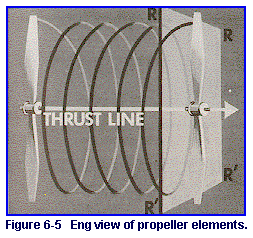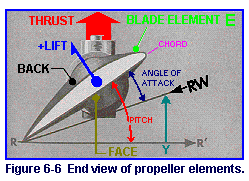 |
|||||
| Home | Research | For Teachers | HISTORY Level 1 Level 2 Level 3 |
PRINCIPLES Level 1 Level 2 Level 3 |
CAREER Level 1 Level 2 Level 3 |
| Gallery | Hot Links | What's New! | |||
| Web Administration and Tools | |||||
 |
|||||
| Home | Research | For Teachers | HISTORY Level 1 Level 2 Level 3 |
PRINCIPLES Level 1 Level 2 Level 3 |
CAREER Level 1 Level 2 Level 3 |
| Gallery | Hot Links | What's New! | |||
| Web Administration and Tools | |||||
![]()
| We can say that the propeller is the action end of an aircraft's reciprocating engine, because it converts the useful energy of the engine into thrust as it spins around and around. The propeller has the general shape of a wing, but the camber and chord (curvature and cross-sectional length) of each section of the propeller are different, as shown in Figure 6-4 . The wing provides lift upward, while the propeller provides lift forward. |
|
| The wing has only one motion which is forward, while the
propeller has forward and rotary motion. The path of these two motions is like a corkscrew
as the propeller goes through the air (see figure 6-5 ). Like a wing, a propeller blade has a thick leading edge and a thin trailing edge. The blade back is the curved portion and is like the top of a wing. The blade face is comparatively flat and corresponds to the underside of a wing (see figure 6-6 for definitions of blade back and blade face). The blade shank is thick for strength and fits into a hub which is attached to the crankshaft directly or indirectly. The outer end of the blade is called the tip. Blade pitch is loosely defined as the angle made by the chord of the blade and its plane of rotation, as shown in Figure 6-6 . When the angle is great, the propeller is said to have high pitch. A high-pitch propeller will take a bigger bit of air and move the aircraft farther forward in one rotation than will a low-pitch propeller. |
 |
| Blade pitch is loosely defined as the angle made by the chord of the blade and its plane of rotation, as shown in Figure 6-6 . When the angle is great, the propeller is said to have high pitch. A high-pitch propeller will take a bigger bit of air and move the aircraft farther forward in one rotation than will a low-pitch propeller. Propellers may be classified as to whether the blade pitch is fixed or variable. The demands on the propeller differ according to circumstances. For example, in takeoffs and climbs more power is needed, and this can best be provided by low pitch. For speed at cruising altitude, high pitch will do the best job. A fixed-pitch propeller is a compromise. |  |
There are two types of variable-pitch propellers adjustable and controllable. The adjustable propeller's pitch can be changed only by a mechanic to serve a particular purpose-speed or power. The controllable-pitch propeller permits pilots to change pitch to more ideally fit their requirements at the moment. In different aircraft, this is done by electrical or hydraulic means. In modern aircraft, it is done automatically, and the propellers are referred to as constant-speed propellers. As power requirements vary, the pitch automatically changes, keeping the engine and the propeller operating at a constant rpm. If the rpm rate increases, as in a dive, a governor on the hydraulic system changes the blade pitch to a higher angle. This acts as a brake on the crankshaft. If the rpm rate decreases, as in a climb, the blade pitch is lowered and the crankshaft rpm can increase. The constant-speed propeller thus ensures that the pitch is always set at the most efficient angle so that the engine can run at a desired constant rpm regardless of altitude or forward speed.
The constant-speed propellers have a full-feathering capability. Feathering means to turn the blade approximately parallel with the line of flight, thus equalizing the pressure on the face and back of the blade and stopping the propeller. Feathering is necessary if for some reason the propeller is not being driven by the engine and is windmilling, a situation that can damage the engine and increase drag on the aircraft.
Most controllable-pitch and constant-speed propellers also are capable of being reversed. This is done by rotating the blades to a negative or reverse pitch. Reversible propellers push air forward, reducing the required landing distance as well as reducing wear on tires and brakes.
Send all comments to ![]() aeromaster@eng.fiu.edu
aeromaster@eng.fiu.edu
© 1995-98 ALLSTAR Network. All rights reserved worldwide.
| Funded in part by | From Civil Air Patrol Educational Materials |
Updated: February 23, 1999